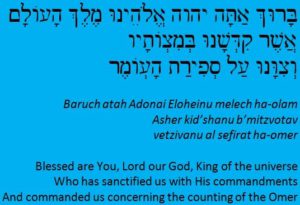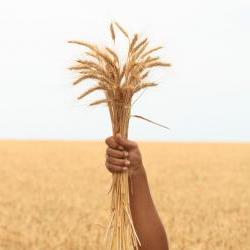Are you ready to begin counting the Omer?
During Passover and the Feast of Unleavened Bread, some of the things we do are traditions. But not this one; this is a command:
You shall also count for yourselves from the day after the Sabbath, from the day when you brought in the sheaf of the wave offering; there shall be seven complete Sabbaths. You shall count fifty days to the day after the seventh Sabbath; then you shall present a new grain offering to the LORD (Leviticus 23:15-16).
עמר omer (Strong’s Hebrew word H6016) is the Hebrew word for “sheaf” in the above passage. It refers back to the previous verses:
Speak to the sons of Israel and say to them, “When you enter the land which I am going to give to you and reap its harvest, then you shall bring in the sheaf of the first fruits of your harvest to the priest. He shall wave the sheaf before the LORD for you to be accepted; on the day after the sabbath the priest shall wave it” (Leviticus 23:10-11).
The only other place this 50-day count from the wave sheaf is mentioned in Scripture is in Deuteronomy 16. However, in other passages Shavuot – the Feast of Weeks at the end of this count – is also called Pentecost, πεντηκοστή pentekoste, in Greek (2 Maccabees 12:32, Tobit 2:1, Acts 2:1, Acts 20:16, 1 Corinthians 16:8). Thayer identifies this as meaning “the fiftieth day.”
You shall count seven weeks for yourself; you shall begin to count seven weeks from the time you begin to put the sickle to the standing grain. Then you shall celebrate the Feast of Weeks to the LORD your God …” (Deuteronomy 16:9-10).
When the day of Pentecost had come, they were all together in one place (Acts 2:1).
Though no specific date is mentioned, the command to wave the sheaf of the first fruits immediately follows the instructions for Passover and the Feast of Unleavened Bread (Leviticus 23). Traditionally, “the day after the Sabbath” has been understood to mean the Sabbath after the Passover. Historically, we know that the Children of Israel entered the Promised Land on the tenth day of the first month, then they ate the Passover on the fourteenth day, and “the day after the Passover, on that very day, they ate some of the produce of the land, unleavened cakes and parched grain” (Joshua 5:11).
We also know that on the day after the Sabbath following the Passover, Yeshua was raised from the dead as the first fruits of the resurrection (Matthew 28:1-8, 1 Corinthians 15:20). Shavuot, or Pentecost, recorded in the second chapter of Acts is generally thought to have been fifty days after Yeshua’s resurrection.
Traditional Judaism observes a “minor holiday” on the 33rd day of the count, lag b’omer. It is said to commemorate the end of a plague during the time of Rabbi Akiva in the second century, and it has a lot of Kabbalistic undertones. For the Messianic believer, let me suggest a much better interim date in the count.
Yeshua and His Disciples
Yeshua’s resurrection was on the day of the waving of the omer, the wave sheaf. His ascension took place 40 days later (Acts 1:3), and during this time he appeared to more than 500 people, including his disciples (1 Corinthians 15:8). But apparently after his crucifixion, the disciples intended to just go back to doing what they were doing before, as if it was the end of everything they had anticipated (John 21:1-4). Yeshua had different plans, and took this 40-day period to prepare his disciples for their mission. A 40-day period of preparation is a pattern in Scripture. So as you count, look for God to prepare you for what is ahead.
On that fortieth day, Yeshua brought them all together and gave them a promise. He promised them they would receive supernatural power from the Ruach HaKodesh (Holy Spirit) to be his witnesses. Then, as he was departing, the Father also gave them another promise – Yeshua would return. Remember this as you reach the 40th day of your count. Ten days later, after they “were continually devoting themselves to prayer” (Acts 1:14), the promised power of the Ruach HaKodesh came.
When the day of Pentecost had come, they were all together in one place. And suddenly there came from heaven a noise like a violent rushing wind, and it filled the whole house where they were sitting. And there appeared to them tongues as of fire distributing themselves, and they rested on each one of them. And they were all filled with the Holy Spirit and began to speak with other tongues, as the Spirit was giving them utterance (Acts 2:1-4).
We are now anticipating the fulfillment of the second promise, the return and reign of our Messiah, Yeshua!
Let’s Count
We count 50 days, beginning with the day of the wave sheaf – the offering of the first fruits, the day of the resurrection of Messiah Yeshua. We count up, not count down, to the fiftieth day. We end on the fiftieth day, the day of the Feast of Weeks, Shavuot (Pentecost).
Three times in the two passages from the Torah we read the command “you shall count.” The Hebrew word used is ספר saphar, simply meaning to count or number. It is important not just to recognize when the fiftieth day has arrived, but to count each day until it does. This builds the anticipation for the next celebration.

Traditionally, each day (usually in the evening that begins the day) a blessing is recited:
Baruch atah A-donai E-loheinu Melekh Ha-olam
Asher kid’shanu b’mitzvotav v’tzivanu al S’firat Ha-omer
Blessed are You, Lord our God, King of the Universe
Who has sanctified us with His commandments and commanded us to count the Omer.
Then, the day is “counted” by stating “Today is ___ days of the Omer,” and if it has been more than one week, adding “which is ___ weeks and ___ days.” This is tradition; how you do it is not important, but doing it is.
If you aren’t comfortable with some of the Hebrew words, then just count in English (or whatever your native tongue is) “Today is day ___ of the wave sheaf.” Or even better, you could count “Today is day ___ of the resurrection.”
You can count with me at https://Omer.MessianicLight.com or follow us at The Messianic Light on Facebook.


I checked the book you recommended. The price is prohibitive fir me
I’m sorry, it appears that right now the Prayer Book and Life Cycle Guide is only available from third-party sellers and the price has been inflated. I have the daily Scriptures posted at my site, Counting the Omer. Thanks for reading.
I’m having trouble finding out when to start counting the omer. Please help?.
Signed,
Confused
The question as to when to start has two different answers. Do you fellowship with a group? If so, when do the people you fellowship with celebrate Shavuot?
If they will observe Shavuot on Sunday, May 31, as many Christian and Hebrew Roots congregations do, then start the count tomorrow (or tonight at sundown). However, if you fellowship with a Jewish or Messianic Jewish community, then you will probably keep Shavuot on Friday, May 29, and would start the count yesterday, the day after the High Sabbath. Scripture is ambiguous and can be interpreted either way. The most important thing is to count, and the best way is to do it in unity with your local congregation (if you have one).
I discuss this further in my post Shavuot – The Undated Holiday.